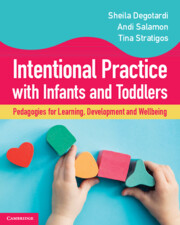Refine search
Actions for selected content:
241 results
6 - ‘Ordering’ Infants
-
- Book:
- Making Babies in Early Modern England
- Published online:
- 12 December 2025
- Print publication:
- 29 January 2026, pp 166-202
-
- Chapter
-
- You have access
- Open access
- HTML
- Export citation
Chapter 9 - Conceptual PlayWorlds: Play-based learning and intentionality
-
- Book:
- Play in the Early Years
- Published online:
- 12 December 2025
- Print publication:
- 11 December 2025, pp 178-201
-
- Chapter
- Export citation
Chapter 2 - Children’s perspectives on play
-
- Book:
- Play in the Early Years
- Published online:
- 12 December 2025
- Print publication:
- 11 December 2025, pp 24-43
-
- Chapter
- Export citation
Chapter 5 - Meaning expression through music in teacher–child interactions
-
-
- Book:
- The Arts and Meaning-Making with Children
- Published online:
- 11 September 2025
- Print publication:
- 25 September 2025, pp 92-112
-
- Chapter
- Export citation
Chapter 2 - Embodied music-making, singing and song-making: Young children’s agency, identity and world-making through music
-
-
- Book:
- The Arts and Meaning-Making with Children
- Published online:
- 11 September 2025
- Print publication:
- 25 September 2025, pp 23-42
-
- Chapter
- Export citation
Assessment and prediction of human milk intake in late infancy
-
- Journal:
- Proceedings of the Nutrition Society / Volume 84 / Issue OCE2 / June 2025
- Published online by Cambridge University Press:
- 24 July 2025, E185
-
- Article
-
- You have access
- Export citation
From research to food safety and food policy: a focus on infants and young children
-
- Journal:
- Proceedings of the Nutrition Society / Volume 84 / Issue OCE2 / June 2025
- Published online by Cambridge University Press:
- 24 July 2025, E160
-
- Article
-
- You have access
- Export citation
Neonatal and 3-month cerebrovascular oxygenation, stability, and extraction in congenital heart disease versus control infants
-
- Journal:
- Journal of Clinical and Translational Science / Volume 9 / Issue 1 / 2025
- Published online by Cambridge University Press:
- 21 July 2025, e175
-
- Article
-
- You have access
- Open access
- HTML
- Export citation

Intentional Practice with Infants and Toddlers
- Pedagogies for Learning, Development and Wellbeing
-
- Published online:
- 17 June 2025
- Print publication:
- 12 June 2025
-
- Textbook
- Export citation
11 - Assessing, planning for and communicating learning
-
- Book:
- Intentional Practice with Infants and Toddlers
- Published online:
- 17 June 2025
- Print publication:
- 12 June 2025, pp 282-308
-
- Chapter
- Export citation
9 - Social cultures and belonging
-
- Book:
- Intentional Practice with Infants and Toddlers
- Published online:
- 17 June 2025
- Print publication:
- 12 June 2025, pp 227-254
-
- Chapter
- Export citation
3 - Pedagogy as care
-
- Book:
- Intentional Practice with Infants and Toddlers
- Published online:
- 17 June 2025
- Print publication:
- 12 June 2025, pp 64-81
-
- Chapter
- Export citation
Introduction
-
- Book:
- Intentional Practice with Infants and Toddlers
- Published online:
- 17 June 2025
- Print publication:
- 12 June 2025, pp 1-15
-
- Chapter
- Export citation
7 - Creating a language-rich environment
-
- Book:
- Intentional Practice with Infants and Toddlers
- Published online:
- 17 June 2025
- Print publication:
- 12 June 2025, pp 167-199
-
- Chapter
- Export citation
8 - Fostering knowing, thinking and theorising
-
- Book:
- Intentional Practice with Infants and Toddlers
- Published online:
- 17 June 2025
- Print publication:
- 12 June 2025, pp 200-226
-
- Chapter
- Export citation
6 - Building emotional wellbeing
-
- Book:
- Intentional Practice with Infants and Toddlers
- Published online:
- 17 June 2025
- Print publication:
- 12 June 2025, pp 136-166
-
- Chapter
- Export citation
4 - Environments for learning
-
- Book:
- Intentional Practice with Infants and Toddlers
- Published online:
- 17 June 2025
- Print publication:
- 12 June 2025, pp 82-111
-
- Chapter
- Export citation
10 - Learning in and through the arts
-
- Book:
- Intentional Practice with Infants and Toddlers
- Published online:
- 17 June 2025
- Print publication:
- 12 June 2025, pp 255-281
-
- Chapter
- Export citation
2 - Perspectives on quality
-
- Book:
- Intentional Practice with Infants and Toddlers
- Published online:
- 17 June 2025
- Print publication:
- 12 June 2025, pp 44-63
-
- Chapter
- Export citation
5 - Promoting physical health for holistic wellbeing
-
- Book:
- Intentional Practice with Infants and Toddlers
- Published online:
- 17 June 2025
- Print publication:
- 12 June 2025, pp 112-135
-
- Chapter
- Export citation
